Preserving Autumn: Marisa’s Apple Butter Method
Written by Marisa McClellan of Food in Jars.
In recent years, apple and pear butters have become integral parts of my fall. I spoon pear butter into my morning yogurt and spread apple butter on scones (often atop a primary layer of peanut butter).
They are sweet, fairly healthy (as fruit spreads go) and I can’t bear to head into winter without five or six pints squirreled away in my coat closet.
I tend to make fruit butters in a two-day process. Here’s how I typically do it.
Cutting & Cooking
Starting with about seven pounds of whole pears or apples, I simply cut them into chunks (the apples get peeled, but I leave the skins on the pears) and cook them down into sauce with a little bit of water or cider, as Aimee demonstrated with her Classic Applesauce. When they can be squished with the flat side of a wooden spoon, I puree them with an immersion blender.
If you don’t have an immersion blender, you can use a regular blender (working carefully in batches) or a food mill to create a smooth sauce from the cooked fruit. If you simply wanted sauce, you could stop right here. Or you can proceed with cooking the sauce down into butter.
From Applesauce to Apple Butter
The evolution from sauce to butter can take anywhere from three to five hours on the stove top at its lowest setting, depending on three things:
- the amount of butter you’re making
- the width of your pot (wider pot means more space for evaporation)
- the level of heat that you cook over
This is best done on a lazy Sunday afternoon, so that you can give it a stir every 15 or 20 minutes. If you have a splatter shield, the kind typically used for frying, use it here, as fruit butters can get a bit sputtery while cooking down.
Alternately, if you don’t have that kind of time, you can put your fruit sauce into a slow cooker and let it slowly cook down overnight or while you’re at work.
You can also make the sauce one day, refrigerate it overnight and then cook it down into the butter the following day (or even a few days down the line).
While it cooks down, I like to add:
- 3-4 teaspoons of cinnamon
- about half a freshly grated nutmeg
- some ground cloves
- a cup or two of honey and/or sugar
The amount of sweetener is up to you, although you should add some, as it helps with the preservation of your finished product. The reason you don’t need much sweetener is because you’ve concentrated the natural sweetness of the fruit by cooking the liquid out of the fruit.
Keep tasting, as it’s the best way to find a balance of spices and sweetness that works for you.
Jarring & Processing
Once the butter is thick, seasoned and spreadable, get your jars out. I find that my typical batch makes 5-6 pints of butter, but your output may vary.
Pour the hot fruit butter into clean jars, wipe rims with a clean cloth, apply lids and rings and process in a boiling water canner for 20 minutes (starting the time when the water returns to a boil). (See Canning 101: The Basics for further instructions, if needed).
When the time is up, remove the jars from the water and let them cool on a towel-lined countertop. When the jars are cool to the touch, check the seals by removing the rings and lifting the jars by the edges of the lid. A good seal means that the lid will hold fast.
Label your jars of fruit butter with the variety and the date. Store in a cool, dark place for up to six months.
It may be not as pretty as a summer jam, but apple butter packs a punch of flavor! What’s your pick: fruit butter or jam?

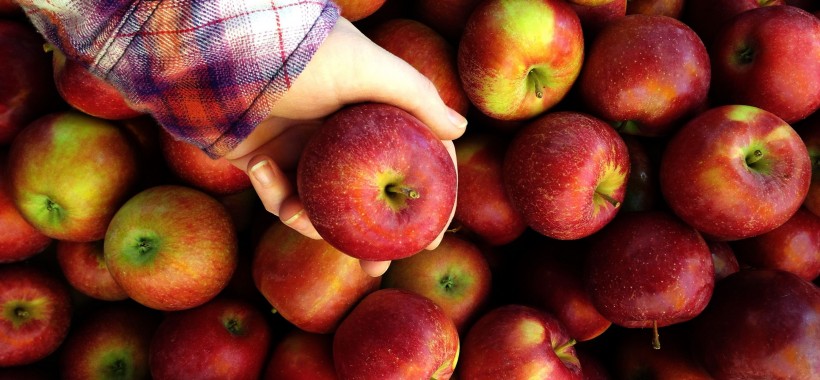
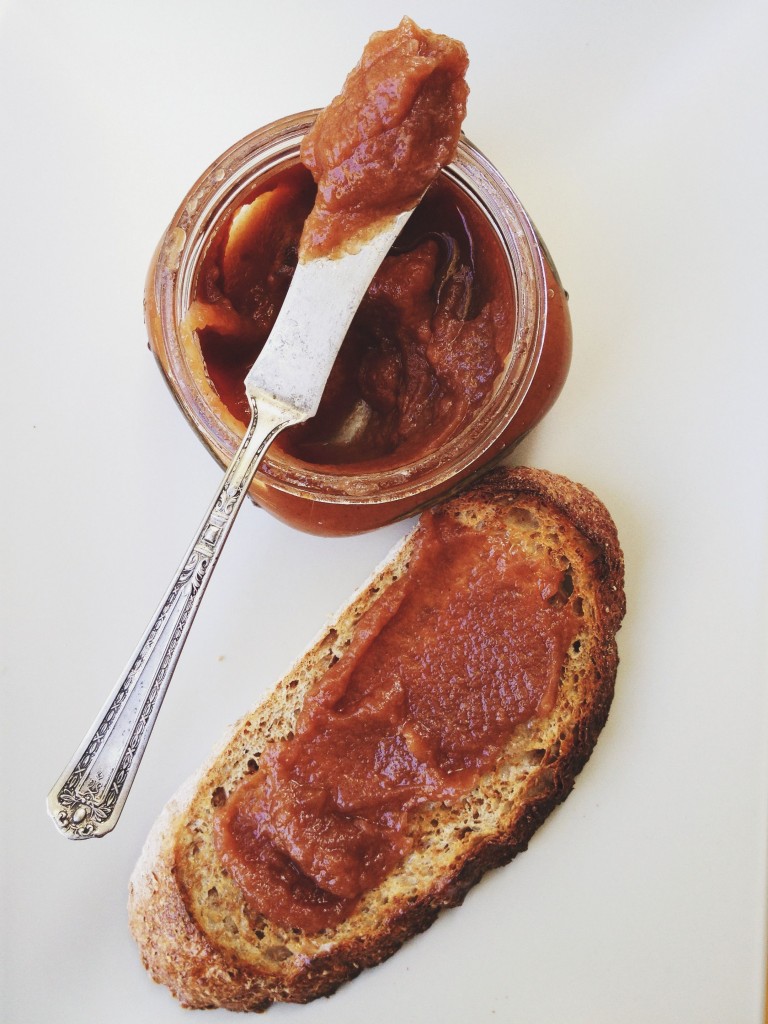

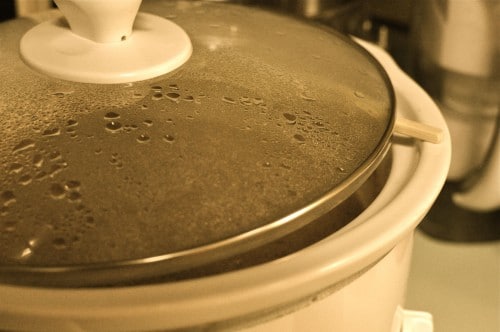
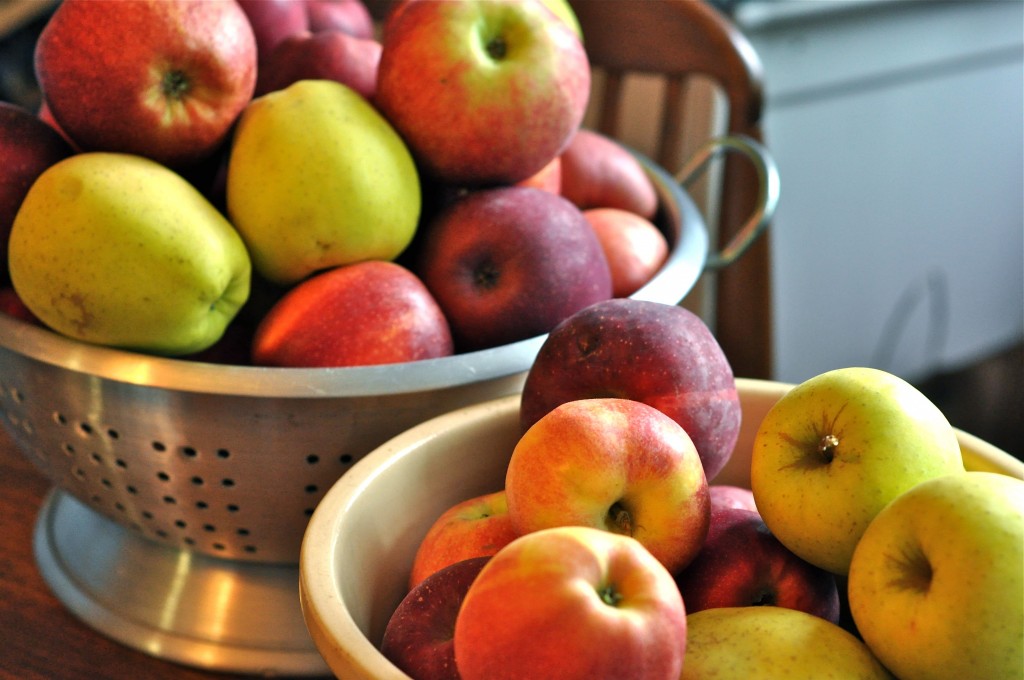
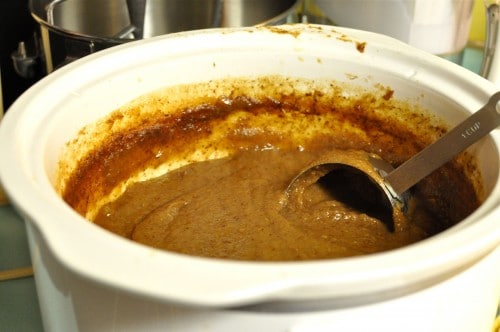
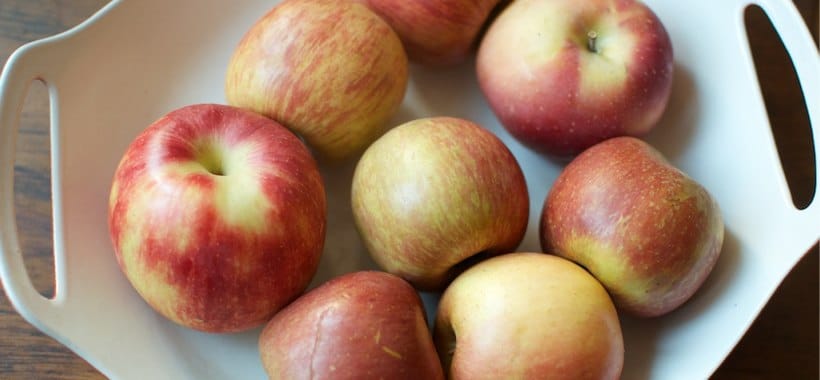
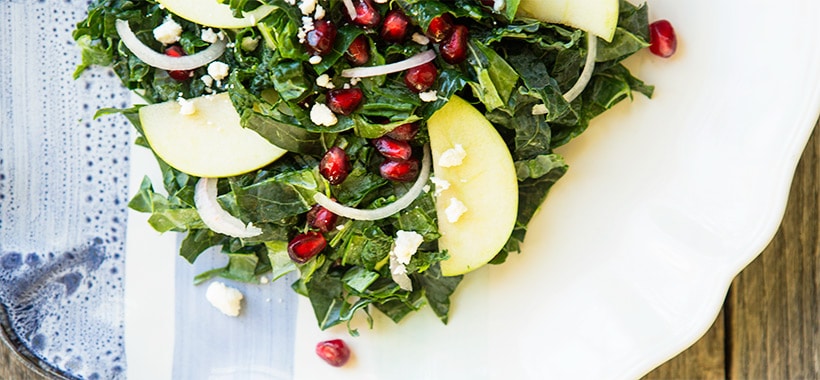
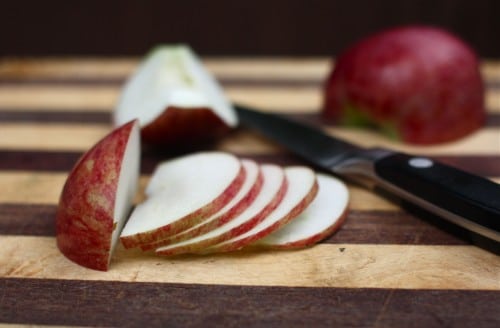
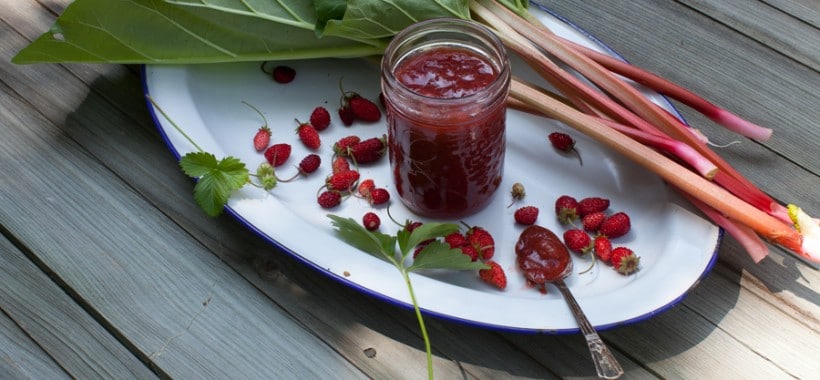

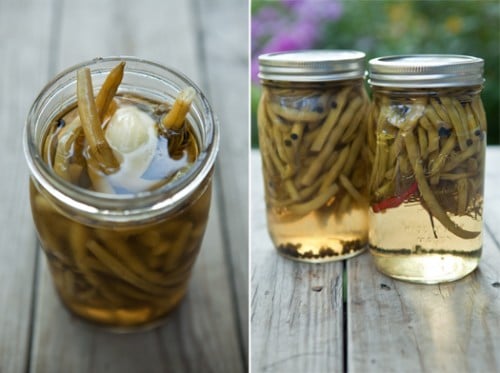
I love the great tutorials on this site. I’ve been making apple butter for years, both for the family & for Christmas gifts. I developed my own method which has worked well for me. Here it is: I have a Saftborn juicer & make apple juice. When the juice had been extracted, I was left with the pulp of the apples. I started running the pulp through the food mill, adding sugar & the spices, re-heating, & filling it into jars & canning it. All the recipes for making apple butter that I found involved cooking the apples for long periods on a low temperature in order to cook off the juice. It made sense to me since the juice was extracted already, that I could do something with the pulp instead of throwing it away. I’ve had a gourmet chef ask me for my “secret” family recipe, and that’s it!
Becky, That’s brilliant!
Love this idea. ‘Secret family recipe’ — that’s funny!
love this method!
I love the idea, but does it taste as apple-y? I would worry that so much of the good tasty stuff would be in the juice.
I made some ape butter for my daughter’s wedding in April and have been storing it in the freezer. We took it out to decorate the tops of the jars and would like to re-freeze it. Is it ok to freeze and re-freeze ape butter?
I’m quite curious about apple butter; I’ve never tasted it before. I have had apple cinnamon jelly, do you think it would be similar in flavor if not consistency?
Apple Butter is the bomb.. it is so delicious. no comparison to apple jelly. and the texture is yummy as well. hope you try it soon.
I have always wondered how apple butter is made. Wow, really easy. Great post as always
Becky, that sounds like a terrific and frugal technique!
Kara, apple butter has a richer flavor than an apple jelly (which often tastes quite delicate). However, I find that I prefer butters to jellies.
Alison, thanks!
i totally agree Marisa. Butters are really tasty. thanks for the recipe
Can I just freeze the apple butter in jars if I don’t have a canner?
Amber, you don’t need a ‘canner’. When I started, I just used my biggest pot, filled it with water and got the party started. The jar lifters are essential, though, but you can get them at Canadian Tire for like $3. Good luck and write if you have questions!
I just use tongs. Jar lifters would be nice, but I’ve never gotten around to it, and my regular kitchen tongs do a fine job.
Amber, you can freeze apple butter, although I’ve found that freezing can leave it with a gummy consistency. If you do freeze it, make sure to leave plenty of headspace.
I’ve been making apple butter for about 10 years. I don’t peel the apples before cooking them, and I use a food mill to make it smooth. Freshly ground spices and a variety of apples will also give apple butter layers of flavor.
I give apple butter and other things I’ve canned as gifts at Christmas, and the one year I didn’t? Phone calls, empty jars in the mail, and claims that I didn’t love them anymore.
Give apple butter a chance!
I love apple butter! I’m planning on making a bunch to give away for Christmas.
That is the same way that I make my apple butter! In my opinion it is just as good as the old fashioned stuff made in a copper kettle. The nice thing about the copper kettle though is that you make a whole lot more at one time.
After trying my hand at butters last year I am addicted. I made a pear cardamom last year that I adored. This year I will be making pear with tonka bean.
Use the same method with plums to make ‘lekvar’- my godmother actually cooks it down in the oven so she doesn’t need to stir it very much- leave the peels on- it will not have the smooth texture of apple butter.
Simple bites- any advice on orange marmalade? I would love to give gifts from the local fruits
I’m thinking of making this today – I have a vanilla bean dying to be used – think it would be good or no?
Ms. Pink, I think that would be delicious!
I love to make apple butter too. I make it out of the peels of the apples after my sauce is finished. I love to use all the apple and not use my sauce up. The peels have natural pectin in them and cook up beautifully and very tasty.
I’ve never made apple butter before, but I was handed a ten-pound bag of apples last week so I figured why not? I can make jam, I can make apple butter. The results are on the stove.
I found that the butter step took no time at all. 3-5 hours? Try 3-5 minutes. The cooked apples were practically already butter consistency when I pushed them through a sieve (to get the skins out). Maybe my neighbor’s apples are starchier than most? I’m scrambling to get my jars prepped right this minute instead of in a few hours. And it looks like it’s going to be challenging to get it neatly into small jars. What I need is a heatproof pastry bag. 🙂
My kitchen smells like Fall — thanks for the timely recipe.
PS: Even though I used a chopstick to eliminate the air bubbles, the jars that just came out of the canner show LOTS of evil air pockets in my lovely apple butter. Boo!
I think I’ll be making this this weekend as we just came home from a you-pick orchard this afternoon with 16 pounds of apples . . . I can’t wait to use the crockpot option . . . genius!
Thanks again, Marisa! I’ve been enjoying reading your blog (along with all of Simple Bites and Simple Organic) regularly and have truly been inspired (by the way, your vanilla strawberry rhubarb butter has become my new Sunday toast staple!) Yum!
Best,
Sarah
I made my very first batch of apple butter yesterday afternoon/evening! I didn’t use this exact recipe because I don’t have a crock pot that’s large enough. It took me 4 hours…but I think my first canning experience was a smashing success!
I’ve always done apple butter on the stove top, but I decided to try the slow cooker method this weekend. I cooked it for nine hours on low and the mixture didn’t reduce at all. Bleah. Then I came back over here and saw from the photo something that should have been obvious to me. I wouldn’t cook it covered on the stove, so how come I didn’t think to vent the lid? I don’t use a slow cooker all that often, as you can tell. I’m transferring to the stove top to finish up, but I think it will be all right in the end. 🙂
All right — I’m going to have to hit my neighbors up for some of the apples from their tree! I just can’t resist this.
Guys, I’m so sorry that my post wasn’t clearer! I didn’t mean to make you crazy with the slow cooker method.
I want to make prune butter. Would you use the same basic process to do so? Thanks.
Do you mean making butter from Italian plum prunes? If so, the proportions would be the same. However, if you’re asking about making fruit butter from dried prunes, unfortunately, I cannot help. That’s not something I’ve done before.
if you are going to leave the skins on….as the apple sauce recipe linked does this…..should I just use a food mill to get all the chunks out after the apples have softened?
What if you didn’t can it right away and its been in the fridge? We’ve eaten some, but I’d now like to can the rest. Do I have to heat it back up or is it too late to can and I should just freeze it? Thanks 🙂
Dianne, you could easily reheat it, pack it into pint (or smaller) jars and process it as instructed in this blog post.
I made a big batch of apple butter before Christmas this year and it’s really delish. I got a real deal on apples from a large local grocery that has the “scratch and dent” produce section–3 lb. bags of breaburn, macintosh, winesap and rome for $1 each, not more than a small handfull from each bag went to compost instead of the cookpot. I found that after cooking stovetop and mashing the chunky pieces down, it was very very fast to put them in the oven in glass baking pans, casseroles and and enamel dutch oven and put the oven on the convection setting. Keep stirring and turning the pans every 20 minutes or so. Cut the cooking time nearly in half! I also find that leaving the peels in the mixture until the mixture is strained helps it to hold together when stored.
I just made apple butter yesterday – it isn’t smooth. I cooked the apples with skins in the crock pot over night. Then in the blender to puree them – added honey instead of sugar & the spices and cooked on the stove till smooth. Put in jars and processed (steamed) for 20 minutes. What would cause the butter to be thicker than normal?
This time of year, the apples we get have been in storage for several months, if not longer. That means that they’ve started to dry out a bit, which could have led to your thicker apple butter. Because they had less moisture to start out, they cooked down faster than apple butters made in the late summer or fall. It’s just a thought, though. Every batch is going to be a little bit different.
I feel like this is such a silly question, but my apple butter, once refrigerated is SO HARD. did i do this wrong? or do i just need to put the jar in warm water and soften it again? thanks!
It shouldn’t be hard at all, Josie. It should be spreadable. Perhaps you over-reduced it. You could warm it and thin it with a little apple juice. Sorry about that!
Do you have a Apple rhubarb butter recipe